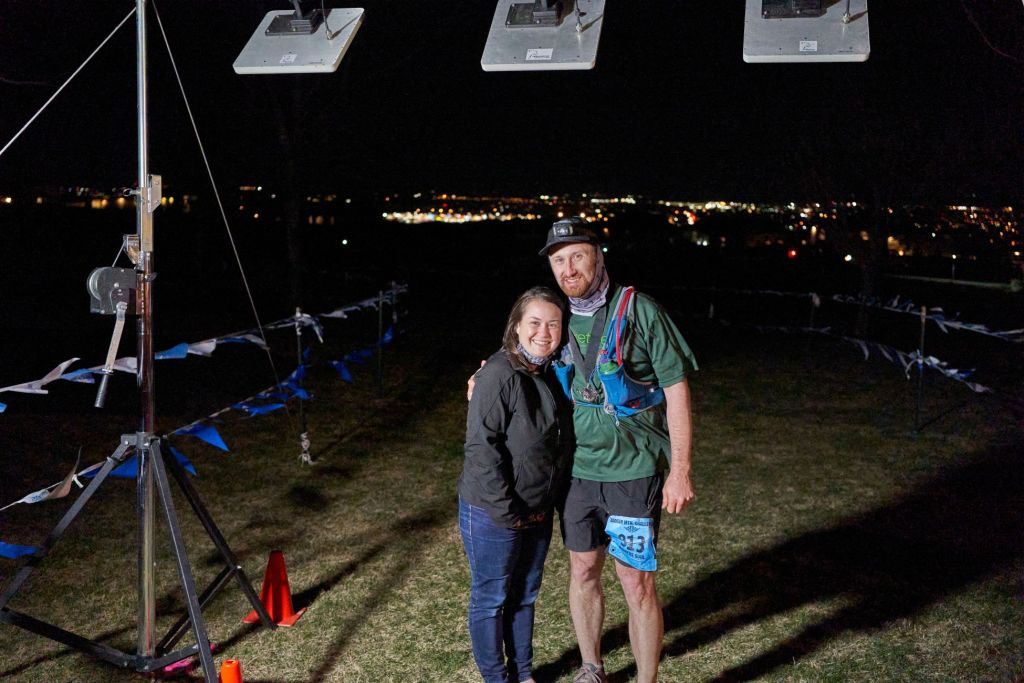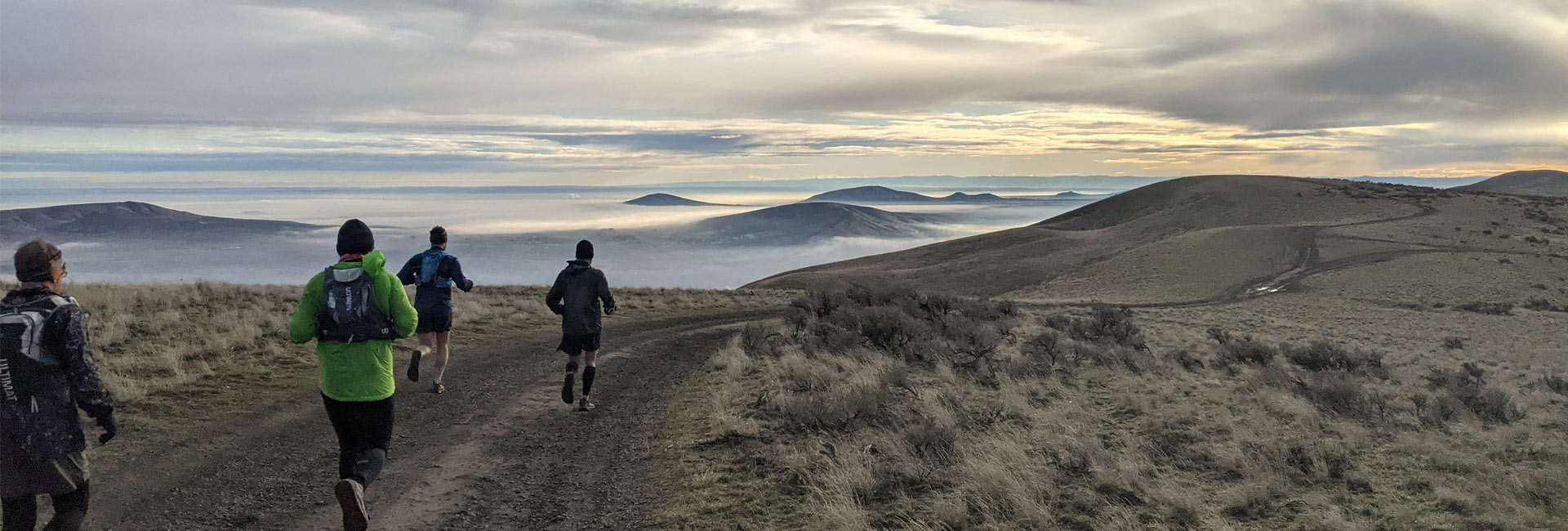I think it all started when Julie Reathaford was hired — this dogged pursuit of achieving more.
Ken Call had decided to sponsor the Badger Mountain Challenge, which is a long race. They feature a 100-mile distance, a 50-mile distance, a 50 km and a 15 km. You can even opt to carry a weight on your back or your front and do the ruck race. The longest distance I had previously conquered was an ultra-marathon in Spokane called the Chocolate Chip Cookie 50k. My training for that … in one word … meandering.
Working alongside Julie and getting to know her husband Jason, the race director for the Badger Mountain Challenge, I was getting more exposure to the endurance runners world. I began to realize that if I wanted to achieve my goal of running a longer distance than the 50 km, I was going to need to focus. To be clear, I did have a decent base of running about 18 to 22 miles per week for the previous 5 to 6 months, albeit most of it on a treadmill.
As we were discussing the race in the clinic one day after I’d decided I was going to run the 50 mile distance, Julie suggested that I might want to document my training. Perhaps she knew, perhaps she was just brainstorming ideas for marketing, but what that turned into was a more focused training regimen than I have ever undergone before.
I began documenting my training by recording Facebook live videos in the mornings before I would start my exercise for the day. This was admittedly awkward at first and misguided to a degree in that I was just learning on the job. Although I had run an ultra-marathon before, I had not taken a microscope or even any kind of lens to my training. Once I started putting my training plans out there to the world, I started getting a lot more feedback. Overall, this was really, really helpful. Sometimes I realized I was missing significant things in my training, and I had to try to make up for it with the time that remained. In retrospect, I should have started my training about one month earlier. Be that as it may, I got through my videos, and I got through my exercises, and I got through the winter training.
There were some days I was literally running through a foot of snow on a Saturday morning before I went to hang out with my family the rest of the day.
There was even one day when the snow forced a change of plans and I decided to try out Big Cross – a trail near my house that is also where state xc championships are held. While out training that day, a die-hard frisbee golfer friend met me over at a frisbee golf course and I ran a full 18 holes of the frisbee golf course while we played a round. We had to tie stringers on the discs so we wouldn’t lose them in the snow.
The moon illuminates the horizon just beyond the ridge of Badger Mountain during one early morning training run.
I showed up at the 12 hours of Badger — a training event created just for the upcoming race — but, I didn’t do 12 hours mind you. I did 7 hours, and I still only did about 25 miles. Going up and down Badger Mountain as the sole part of the run dramatically increased the amount of elevation I had done, so my time was a bit slower, but the effort was certainly there. I now realize that I should have done one more weekend with a longer run getting closer to the 9- or 10-hour mark in order for my body to fully train for what was about to happen on March 26. I took three weeks of taper. I kept doing about 20 to 25 miles of running along with strengthening and flexibility exercises, and I was documenting this the whole way through Facebook live.
I was getting a lot of questions like “Do you feel ready?” and “What do you think is going to happen in the race?” I kept wanting to correct people and tell them that it wasn’t really a race for me, it was truly and simply a challenge. My goal going into the Badger Mountain Challenge was to complete it under 16 hours and leave with the attitude that I wanted to keep doing something like this again. I’d also made a disclaimer or caveat that it was okay if I never wanted to do the Badger Mountain Challenge ever again, but I wanted to still have the motivation to do some endurance running. I had such a good time doing the training and I was surprised at times as to why I was having fun while I was increasing my mileage on the weekends and training like I’d never trained before.
It was similar to my earlier years in high school when I started playing the drums fairly late and I focused and played so many hours and practiced to try to get as good as my peers. When I did get as good as my peers, I realized I’d only been practicing for a short amount of time, so I kept practicing harder and ended up getting quite good. But even then, it was just hard work and focused practice. We had songs and parts that had to be completed and they were critiqued, and they were judged in my high school band. We were always looking toward that next competition or that next performance. I find structure helpful and that having a race or having a challenge ahead of you with a specific set of goals is somewhat necessary to allow yourself to rise to that challenge or accomplish that goal.
Fast forward to March 26th the day of the race. Well, let’s back up one day. I knew I needed to bring some food on the trip, but I just didn’t have a good gauge as to how much or how supported an ultra-marathon like this would be. My only supported ultra-marathon had only two aid stations and at those stations it was mostly just junk food and soda pop and some chocolate chip cookies. This was fine and it worked but I didn’t know what I was in for with Badger Mountain Challenge.
So, the day before the race I bought most of the snack aisle at the local grocery store. I didn’t actually end up eating any of the snacks that I bought, but I had a good time organizing my backpack and pretending that I was going to. Turns out the aid stations at Badger Mountain Challenge are legit and the volunteers were absolutely amazing.
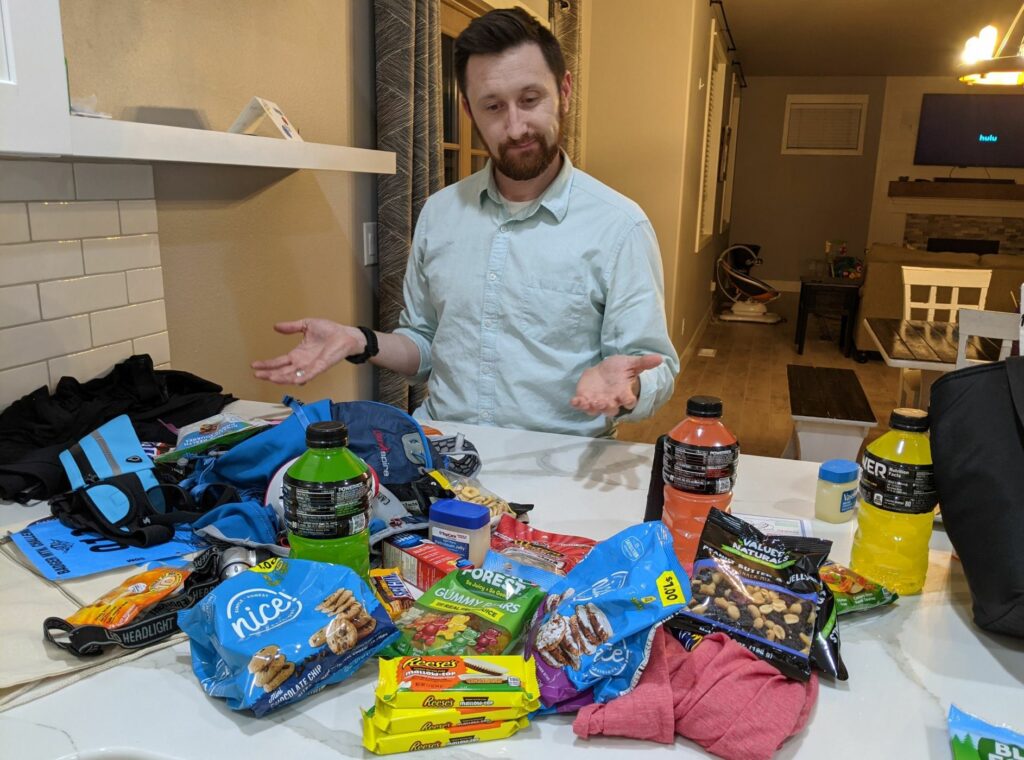
The morning of March 26th my good friend and running buddy Fred picked me up and we drove to the race. I had a mix of emotions that morning, which I relayed on my Facebook live stream. I was truly excited, and I was truly nervous, but I was also truly satisfied with just being there and being able to say that I was going to run an ultra-marathon. Even if I left with just that, had I rolled an ankle at the beginning, I still think I would have had some level of satisfaction (though that would have been very disappointing).
The start was staggered due to COVID regulations. A wave of 10 runners left every 2 minutes. This was organized very well, and race director Jason Reathaford gave a brief motivational speech and informational download to each wave of runners on a fairly windy and pretty cold morning. It was really sunny though, and the weather report projected for sun all day, and it wasn’t wrong.
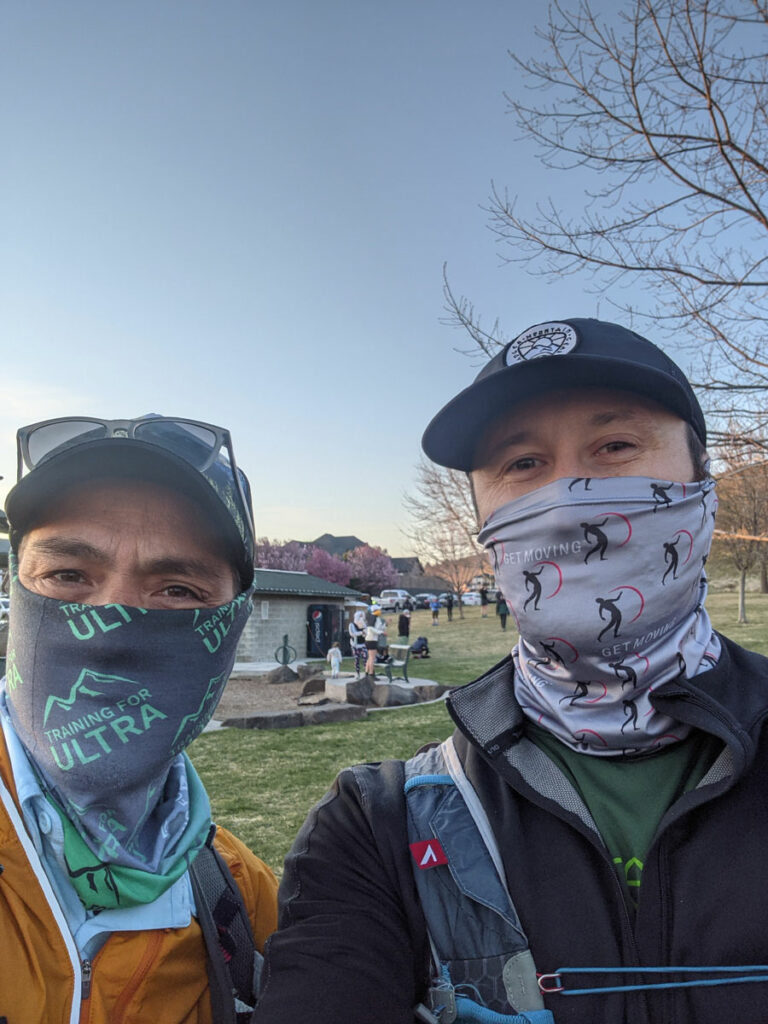
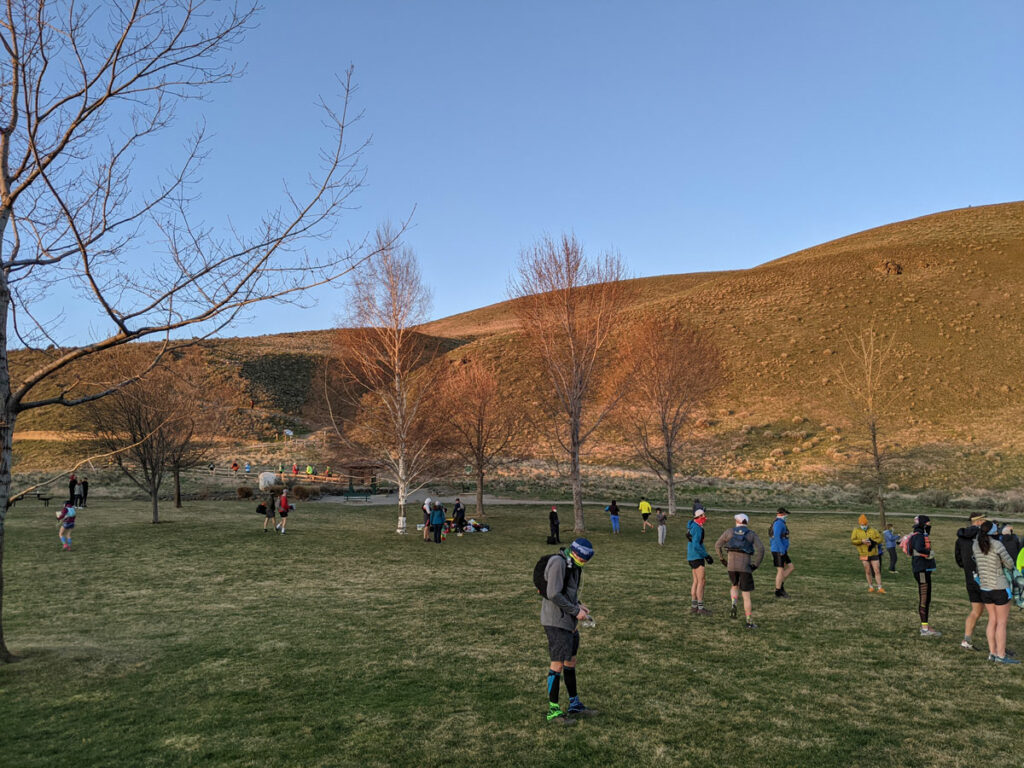
Before my wave started I saw Wes Plate, a YouTuber, with his GoPro on his stick and was intrigued. I’ve been told by a few of my friends about the world of YouTube ultra-marathon runners and how people will do this to document their experience for others to watch and enjoy on YouTube. After the race I ended up watching the video that Wes made a good three or four times, showing family members and enjoying it myself and even posted it up to the clinic Facebook page.
As the run began I wanted to stick to my plan of walking uphill running flats and downhills and wanted to be strict about it. I saw a lot of people going out from the start and jogging or running and mentally I had to decide if I was going to immediately stick to my plan or if I was going to ditch it all in order to look good at the beginning of the race and run. I was surprised at my decision — I decided to walk. So, for the first mile I did a lot of walking because primarily you’re going up badger mountain. There were a couple little stints of jogging, but for the most part I just started the Badger Mountain Challenge with a hike up the mountain. It felt good I was checking my body and checking my legs and checking my back and my neck and everything felt like it was going to work.
I started the run with Fred. We had very similar goals and we trained together ahead of time too. We mostly just wanted to finish. This was the longest distance for both of us. We stuck together through Badger Mountain and along the road between Badger Mountain and Candy Mountain. It was a beautiful morning and the sun was coming up nicely.
But as we got up and over Candy Mountain, I wanted to run down the hill just a little bit faster and that’s about where Fred and I separated. We wished each other good luck and at that point we just had to stick to our training.
As I got down Candy Mountain and approached the culvert the thought crossed my mind that I was already almost 10% done. I do this math when I’m running and it can be to my betterment or to my detriment. I’m constantly thinking about how close I am to halfway done or a quarter of the way done or even in this case 10% done and then calculating that feeling and trying to extrapolate it out to what I would feel at 100%.
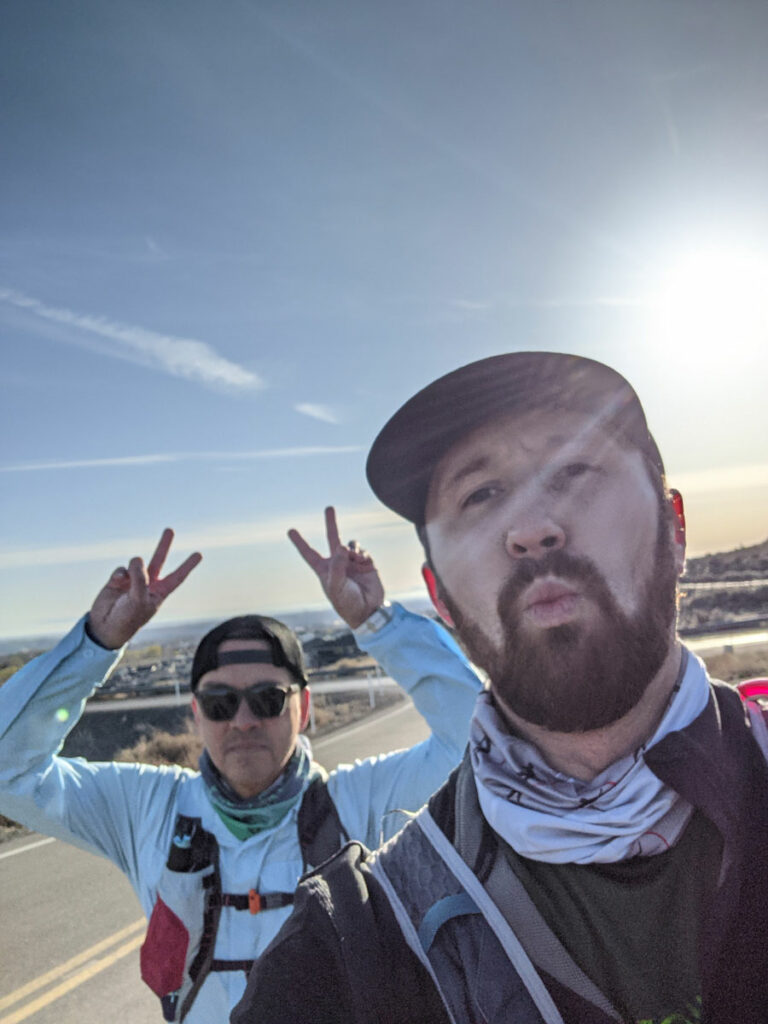
My pace was good my legs felt great I had already eaten the snack and drank some water and some electrolytes. My extrapolation of the feeling at almost 10% was nothing like what I would feel like at 90%. I had no idea the feelings that were about to come.
As I approached Jacobs Road, I had a short conversation with someone who was completing the 100-mile distance. As you approach the Jacobs Road aid station it’s about the 10-mile mark. I said something like, “Just think you’re about 10% done with your race.” He immediately said something to the effect of not thinking about it in distance and thinking about it as time on your feet. That one sentence and that one peek into the thought pattern of someone doing a 100-mile race versus me doing the 50-mile race was telling. Even from the start of the race he was not looking at it as miles completed. He was looking at it as time spent on his feet.
In the moment I knew this is where I needed to get my thinking, but I was not able to get my thinking there in that moment. I had heard the concept of time on your feet mattering more and I knew it. But on race day I had let myself start to think about miles versus time. If I only calculated my time at the 10-mile mark I was going to finish low under 12 hours. I thought, wow, this goal of mine — I’m going to crush it. Needless to say, my first half of the race was faster than my second half.
It comes down to attitude and mental state and outlook and ultimately what your goals are.
I was sending updates to my wife, who was then posting updates up to her Facebook page and linking them to our clinic FB page and to my FB page, so my followers, friends and family could see where I was at. This race did not allow for pacers and did not have live tracking because the volunteer numbers weren’t there to give it that kind of support, so everything was left up to the runner to update those around and those who couldn’t be there.
I got my first real sense of how difficult this was going to be as I was at the McBee aid station at about 18-1/2 miles. This was after the “Endless Vineyards” and the Jeep Trails, which certainly pose a challenge and are certainly underestimated. The Jeep Trails were dusty and at times if you got behind another runner just at the wrong distance you got a mouth full of tap and powder sand. Someone described it as ashtray sand, and I can’t disagree. It’s an odd description but it seems accurate.
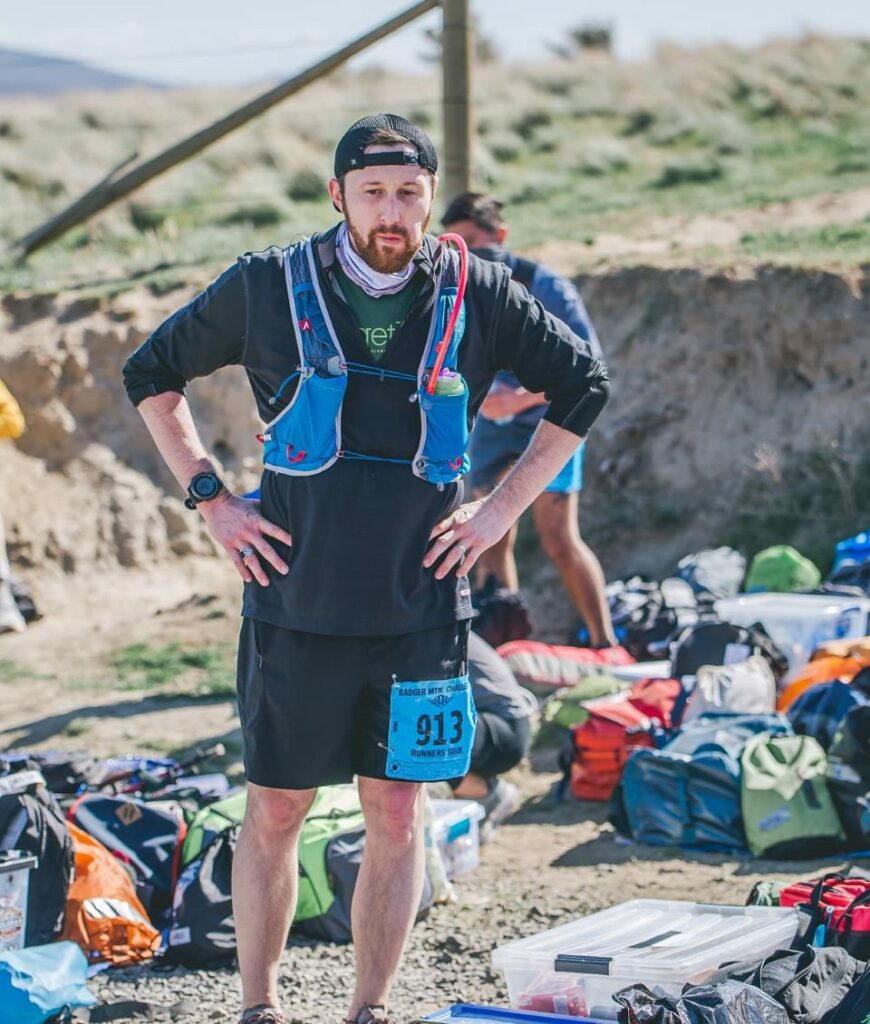
At the McBee aid station I had a hard time finding my backpack. With my hands on my hips, feeling tired and needing a rest, I paused, looking for my pack. Note to self: put something bright on your backpack when you leave it at a drop site.
Once I found my pack I checked to see if I needed any of the snacks in there. At the aid stations so far, I was just getting food shoved in my face and taking some bars and honey stingers for the road. So, I didn’t actually need any of the snacks that I had brought. I unloaded a few of the extra things I was carrying, not that that was smart of me. That, however, wasn’t the issue. The issue was I got my headphones out.
I thought, “I’m going up McBee field and I need some music to motivate me.”
I put on my playlist that helped me get through training, cranked the volume up and started out on the track up McBee. Here is where the mistake was made.
I climbed that hill like I’d never climbed McBee before. I kept a great pace and I pushed hard, and I even passed a couple people on the hill. An older runner gave me a compliment at the top of the hill and told me that I could climb really well. At that moment it made me feel really good to hear him say that because I could tell that he had a lot of experience running long distance races.
What was in store over the next 10 miles was absolute pain.
About halfway down the ridge, maybe a mile after the summit of McBee, I started to experience some leg cramps. I thought, “There’s no way that I’m having cramps at mile 20.” I had done multiple 20-mile runs in my training and never experienced cramps. I had also never done McBee after running for 18-1/2 miles. The mistake was that I did it with music. I went with the pace of the music rather than the pace that my body wanted to go.
So, for the next 10 miles I dealt with cramps as I ran along McBee ridge. And when I say running I mean hobbling and stopping and squatting and stretching and walking and every step hurt from my knees to my stomach. Cramps in your inner thigh are some of the worst and most difficult cramps to deal with. Needless to say, those miles were a little slower than the first 10 miles.
As I got over the McBee ridge and started running down the single track — the single track down McBee is one of the most beautiful and great stretches of running in the entire Tri-Cities area — I hated it. I wanted to enjoy it so badly and the fact that I couldn’t enjoy it because of all these cramps going on in my legs was so frustrating. I grunted in pain and made all kinds of noises that if people had been around me they would have thought, “This guy’s really quite strange.”
My friend Nathan, who had done some of the training for this race with me and who, had there been pacers allowed, would have been one of my pacers, texted me to coordinate support. He’s that kind of friend. He’ll run 10 miles with you just because you need some help. I told him that I had been experiencing cramps over the past 10 miles and he asked me what I had available. I told him I had drank a little bit of pickle juice at the aid station, but I was still feeling a little bit cramping in my legs. He immediately thought to get mustard packets, and he went over to the gas station in Benton City and picked up a handful of mustard packets. It was the most awkward but most beautiful gift I’ve ever received.
I ended up taking in one gas station mustard packet every 30-45 minutes for the remaining 20 miles of the race. At first it was gross, and then my muscles started to loosen up a bit and stop catching so much. Then I was convinced — mustard packets for the win!!
After conquering McBee it was back to the Jeep trails. The talcum-powder, cigarette-ash consistency got in my mouth, in my shoes, and up my nose. I tried to prevent some of it by running with my mask up over my mouth. It helped a little, but by the time I thought to try this, the damage had mostly been done. And nothing could help the feet. It was a feeling of just a little slipping and sliding in the shoe. Noticeable, but not too bad.
In the middle of the Jeep Trails was the Orchard aide station. There were some really nice folks there, including one fella who was chatting with his wife who was volunteering at the aide station. I had seen him in the distance for a while, but had now just caught up to him. I remember starting a conversation with him, but honestly don’t remember how. But, it turned out we both lived in the Tri Cities and we had some mutual contacts in the area. We had about one degree of separation, and now we were trail buddies.
We proceeded to trek together for the next 10+ miles — through the rest of the Jeep Trails, to Demoralizing Hill and through the Endless Vineyards. I thought for sure my friend was going to ditch me for going so slowly at the Jacob’s Road aide station, but we stuck together. He had a lot of negative talk about how he’s “never doing this distance again” and I just kind of nodded along. I was starting to feel a lot of pain too. It hurt. My knees hurt. My feet hurt. I was tired. I was sore already and the race wasn’t even over. My pace had slowed to about 15 minutes per mile, which overall is just a brisk walking pace. Running was less and less and more of the flats were being done as a power walk.
As we got up to the back side of Candy Mountain my new friend and I kept saying, “This is the last hard hill,” thinking that the back side of Badger is easy compared to all of the other hills. Even if my friend was not in the best headspace, it was still nice to commiserate with someone.
Throughout the race I had continued to communicate with my wife, Amy, who was then communicating my race status on Facebook. At the time, I didn’t realize she was taking it that far — I thought perhaps she would have just made a group text with family members who wanted updates. I did one live stream at a little past the mid-way point, and later was inspired to see all the encouragement from people.
Amy was trying to coordinate when to arrive at the finish line and the sun was starting to set. It was after 8pm, and I was still only coming down the front side of Candy Mountain with still 5+ miles to go. I felt a little guilty at this point … here my wife had taken care of the family all day, posted to social media for me, communicated with me, fed the family, put all of the kids to bed, arranged to meet me the finish line, and here I was wanting some sympathy for the pain I was in. It took me some time to think, “Kyle, you did this completely to yourself. You don’t need nor deserve anyone’s sympathy. This is supposed to be fun.”
I was surprised at how I came around in my own head. It was then I realized just how hard what I was doing really was — going 50 miles with 9K feet of elevation gain in a single day. I was doing it for myself. In turn I do it to make myself a better person and to appreciate the great support that I have around me. I have a great family, great community, great work family, and a healthy (enough) body to get me through some hard physical challenges. This is why I do these long distances, to appreciate the activity, myself, and those around me.
I finished the race at about 9:45pm coming in at 13.5 hours. My official time of 13 hours 27 minutes and 30 seconds was good enough to rank me at 51.61% for my age group and I finished 117th overall. Now I want a new pair of shoes, a go pro, and some sunglasses made for running.
